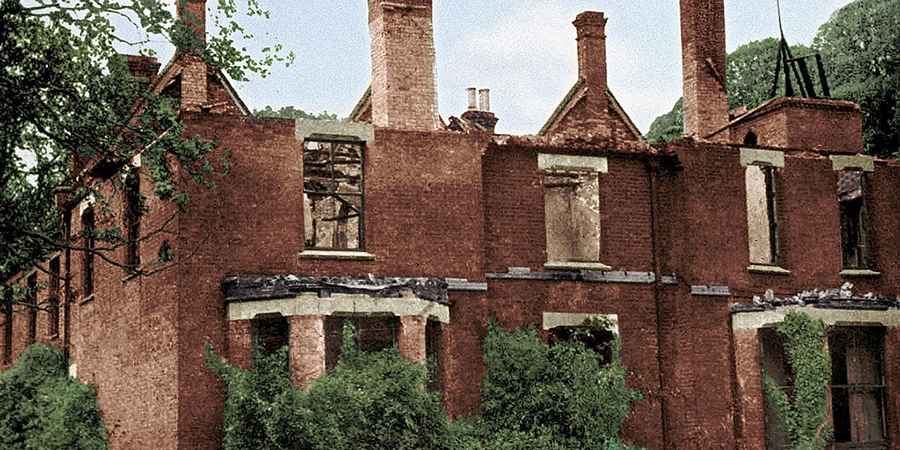From Borley To Enfield: The Decline Of Major Paranormal Cases
January 04, 2024 1:00 AM ‐ Paranormal

Photo: commons.wikimedia.org
Many of us with a love for the paranormal today will have been inducted after reading about some of the most legendary hauntings from the 1970s and 1980s.
These include tales of the eerie Borley Rectory and the infamous Enfield hauntings, but these historic cases were much better documented and left more of a legacy than most modern-day encounters, which seem to be fleeting ghostly encounters. What makes these historical cases unique, and why do such large-scale hauntings appear to be relics of the past?
Take Borley Rectory, which for several decades held the title of the most haunted house in Great Britain, and perhaps it still would have had it not burned to the ground in 1939. Its haunting includes sightings of a ghostly nun and mysterious writings on walls. Harry Price's extensive investigation, despite accusations of sensationalism, was a pioneering step in documenting the paranormal. The case is an important milestone in paranormal history and the source of ghost stories that live on to this day.
Then there's the Rosenheim Poltergeist in late 1960s Germany, where physicist Hans Bender and his team meticulously documented unexplained occurrences around Annemarie Schneider, setting a high bar for scientific inquiry in poltergeist studies but also making headlines around the world.
We also can't forget about the Cheltenham Ghost from the late 19th century. Investigated by Frederic W. H. Myers of the Society for Psychical Research (SPR), this case is one of the earliest structured paranormal investigations. Moving into the 1960s, the Pontefract Poltergeist at 30 East Drive became infamous for its well-documented phenomena, a huge amount of press attention, and a lasting legacy that inspired filmmakers and ghost hunters alike.
The Battersea Poltergeist in the 1950s saw the Hitchings family in London experience phenomena that attracted significant attention, including from researcher Harold Chibbett. And who could overlook the Enfield Poltergeist of the late 1970s? Investigated by Maurice Grosse and Guy Lyon Playfair. This case involved a detailed live-in investigation and has gone on to become almost a framework for the perfect poltergeist case.
More recent, though still notable, are cases like Pete the Poltergeist in late 1990s Cardiff, where SPR's David Fontana examined unexplained events at a lawnmower shop. And the South Shields Poltergeist from 2005–2006, which has been labelled 'one of the most significant cases in the last fifty years.'
So, what sets these historic cases apart from modern reports? One key difference lies in the media and public attention they received. While today's hauntings receive a great deal of media attention, it tends to be fleeting. The vast digital and social media landscape, with its constant stream of content, means that current paranormal stories often emerge and fade quickly, sometimes getting lost or overlooked amidst the deluge of information. They're also often consigned to quirky or alternative news outlets, relegated to the 'odd news' sections or presented as lighter, 'and finally' segments, which tend to downplay their significance compared to the more in-depth and prominent coverage historic cases received.
In contrast, historic cases like those at Borley Rectory or the Enfield Poltergeist garnered sustained media attention, often making front-page headlines in national newspapers and being featured in the main evening news broadcasts. This prolonged focus allowed these stories to deeply embed themselves in the public's consciousness, a phenomenon less commonly seen with today's more transient paranormal reporting.
The difference is not just in the amount of attention but also in its duration and depth, as well as the type of coverage, reflecting how changes in media have influenced the public's engagement with paranormal phenomena. Historical cases often received more serious, in-depth reporting, while contemporary stories tend to be presented in briefer, less formal formats, impacting how they are perceived and remembered.
Another key difference is the academic involvement seen in historic cases, lending them an air of credibility. Organisations such as the Society for Psychical Research and the Ghost Club extensively documented these incidents, and many became the subjects of thorough reports and books. This level of scrutiny and documentation contributed to the stronger credibility of witnesses and the multiple reliable accounts that often accompanied these cases. Perhaps this was due to the fact that cases were researched and reported over a longer period of time, allowing more witnesses to come forward.
Furthermore, these historic cases often became integrated into local and national folklore, influencing tourism and local narratives – an impact less frequently achieved by contemporary hauntings, which tend not to extend much beyond transient online articles on tabloid websites.
The way historic hauntings captured public attention and were documented differs hugely from today's experiences, but that's not the only reason that there's a scarcity of large-scale hauntings today. For instance, advances in mainstream technology, particularly in high-definition cameras and sophisticated audio recording equipment, have revolutionised the way paranormal events are captured and scrutinised. This includes easy-to-use software for enhancing and examining audio and video recordings, which allows for a more detailed investigation of potential paranormal activity. This, combined with a heightened sense of skepticism and a scientific approach to the unexplained, challenges the way we view and validate such phenomena today.
Today, we are quicker to dismiss paranormal stories before they gain press attention. This could be down to a heightened awareness of mental health issues and advancements in psychology. While this has been beneficial in many ways, it also means that unusual claims are often hastily attributed to psychological factors rather than considered potential paranormal phenomena.
We've also become more skeptical due to the saturation of media with sensationalist or fabricated content, which has made us more cynical. In earlier times, with less exposure to such content, people might have been more receptive to extraordinary claims. The widespread knowledge of tools like Photoshop and deepfakes has made the public more wary of photographic and video evidence. The ease of digitally altering images today contrasts sharply with the past, when such tampering was less common and more difficult to achieve convincingly.
Societal attitudes may have also shifted since the big case of the past. Where there once might have been a tendency to give claimants the benefit of the doubt, today's default position leans more towards skepticism, partly fuelled by the debunking of numerous cases over the years.
It's no longer enough to simply share a ghostly encounter. The modern audience demands more concrete evidence, often dismissing reports that lack substantial proof. Individuals reporting paranormal experiences today don't just face scrutiny from friends and family as those of the past might have, but their claims may be picked apart by a global audience of skeptics.
All this means that the days of large-scale hauntings might be behind us and that the ghosts of the past were as much a product of their time as our current understanding is of ours.
Related Content
Daily Horoscopes
You May Also Like
























